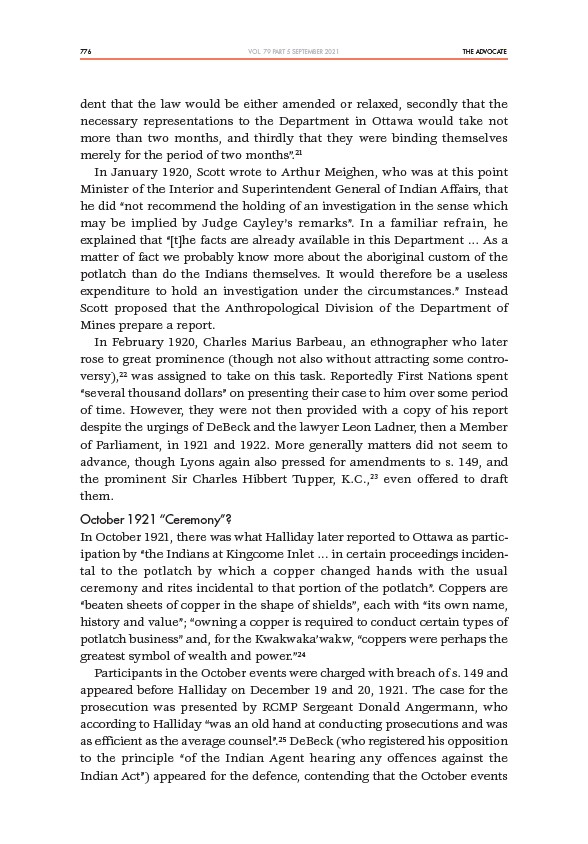
776 THE ADVOCATE
VOL. 79 PART 5 SEPTEMBER 2021
dent that the law would be either amended or relaxed, secondly that the
necessary representations to the Department in Ottawa would take not
more than two months, and thirdly that they were binding themselves
merely for the period of two months”.21
In January 1920, Scott wrote to Arthur Meighen, who was at this point
Minister of the Interior and Superintendent General of Indian Affairs, that
he did “not recommend the holding of an investigation in the sense which
may be implied by Judge Cayley’s remarks”. In a familiar refrain, he
explained that “the facts are already available in this Department … As a
matter of fact we probably know more about the aboriginal custom of the
potlatch than do the Indians themselves. It would therefore be a useless
expenditure to hold an investigation under the circumstances.” Instead
Scott proposed that the Anthropological Division of the Department of
Mines prepare a report.
In February 1920, Charles Marius Barbeau, an ethnographer who later
rose to great prominence (though not also without attracting some controversy),
22 was assigned to take on this task. Reportedly First Nations spent
“several thousand dollars” on presenting their case to him over some period
of time. However, they were not then provided with a copy of his report
despite the urgings of DeBeck and the lawyer Leon Ladner, then a Member
of Parliament, in 1921 and 1922. More generally matters did not seem to
advance, though Lyons again also pressed for amendments to s. 149, and
the prominent Sir Charles Hibbert Tupper, K.C.,23 even offered to draft
them.
October 1921 “Ceremony”?
In October 1921, there was what Halliday later reported to Ottawa as participation
by “the Indians at Kingcome Inlet … in certain proceedings incidental
to the potlatch by which a copper changed hands with the usual
ceremony and rites incidental to that portion of the potlatch”. Coppers are
“beaten sheets of copper in the shape of shields”, each with “its own name,
history and value”; “owning a copper is required to conduct certain types of
potlatch business” and, for the Kwakwaka’wakw, “coppers were perhaps the
greatest symbol of wealth and power.”24
Participants in the October events were charged with breach of s. 149 and
appeared before Halliday on December 19 and 20, 1921. The case for the
prosecution was presented by RCMP Sergeant Donald Angermann, who
according to Halliday “was an old hand at conducting prosecutions and was
as efficient as the average counsel”.25 DeBeck (who registered his opposition
to the principle “of the Indian Agent hearing any offences against the
Indian Act”) appeared for the defence, contending that the October events